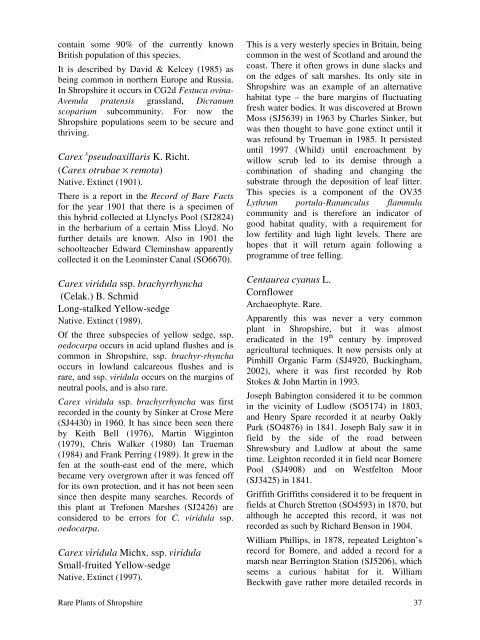Shropshire - Botanical Society of the British Isles
Shropshire - Botanical Society of the British Isles
Shropshire - Botanical Society of the British Isles
- No tags were found...
Create successful ePaper yourself
Turn your PDF publications into a flip-book with our unique Google optimized e-Paper software.
contain some 90% <strong>of</strong> <strong>the</strong> currently known<strong>British</strong> population <strong>of</strong> this species.It is described by David & Kelcey (1985) asbeing common in nor<strong>the</strong>rn Europe and Russia.In <strong>Shropshire</strong> it occurs in CG2d Festuca ovina-Avenula pratensis grassland, Dicranumscoparium subcommunity. For now <strong>the</strong><strong>Shropshire</strong> populations seem to be secure andthriving.Carex x pseudoaxillaris K. Richt.(Carex otrubae × remota)Native. Extinct (1901).There is a report in <strong>the</strong> Record <strong>of</strong> Bare Factsfor <strong>the</strong> year 1901 that <strong>the</strong>re is a specimen <strong>of</strong>this hybrid collected at Llynclys Pool (SJ2824)in <strong>the</strong> herbarium <strong>of</strong> a certain Miss Lloyd. N<strong>of</strong>ur<strong>the</strong>r details are known. Also in 1901 <strong>the</strong>schoolteacher Edward Cleminshaw apparentlycollected it on <strong>the</strong> Leominster Canal (SO6670).Carex viridula ssp. brachyrrhyncha(Celak.) B. SchmidLong-stalked Yellow-sedgeNative. Extinct (1989).Of <strong>the</strong> three subspecies <strong>of</strong> yellow sedge, ssp.oedocarpa occurs in acid upland flushes and iscommon in <strong>Shropshire</strong>, ssp. brachyr-rhynchaoccurs in lowland calcareous flushes and israre, and ssp. viridula occurs on <strong>the</strong> margins <strong>of</strong>neutral pools, and is also rare.Carex viridula ssp. brachyrrhyncha was firstrecorded in <strong>the</strong> county by Sinker at Crose Mere(SJ4430) in 1960. It has since been seen <strong>the</strong>reby Keith Bell (1976), Martin Wigginton(1979), Chris Walker (1980) Ian Trueman(1984) and Frank Perring (1989). It grew in <strong>the</strong>fen at <strong>the</strong> south-east end <strong>of</strong> <strong>the</strong> mere, whichbecame very overgrown after it was fenced <strong>of</strong>ffor its own protection, and it has not been seensince <strong>the</strong>n despite many searches. Records <strong>of</strong>this plant at Trefonen Marshes (SJ2426) areconsidered to be errors for C. viridula ssp.oedocarpa.Carex viridula Michx. ssp. viridulaSmall-fruited Yellow-sedgeNative. Extinct (1997).This is a very westerly species in Britain, beingcommon in <strong>the</strong> west <strong>of</strong> Scotland and around <strong>the</strong>coast. There it <strong>of</strong>ten grows in dune slacks andon <strong>the</strong> edges <strong>of</strong> salt marshes. Its only site in<strong>Shropshire</strong> was an example <strong>of</strong> an alternativehabitat type – <strong>the</strong> bare margins <strong>of</strong> fluctuatingfresh water bodies. It was discovered at BrownMoss (SJ5639) in 1963 by Charles Sinker, butwas <strong>the</strong>n thought to have gone extinct until itwas refound by Trueman in 1985. It persisteduntil 1997 (Whild) until encroachment bywillow scrub led to its demise through acombination <strong>of</strong> shading and changing <strong>the</strong>substrate through <strong>the</strong> deposition <strong>of</strong> leaf litter.This species is a component <strong>of</strong> <strong>the</strong> OV35Lythrum portula-Ranunculus flammulacommunity and is <strong>the</strong>refore an indicator <strong>of</strong>good habitat quality, with a requirement forlow fertility and high light levels. There arehopes that it will return again following aprogramme <strong>of</strong> tree felling.Centaurea cyanus L.CornflowerArchaeophyte. Rare.Apparently this was never a very commonplant in <strong>Shropshire</strong>, but it was almosteradicated in <strong>the</strong> 19 th century by improvedagricultural techniques. It now persists only atPimhill Organic Farm (SJ4920, Buckingham,2002), where it was first recorded by RobStokes & John Martin in 1993.Joseph Babington considered it to be commonin <strong>the</strong> vicinity <strong>of</strong> Ludlow (SO5174) in 1803,and Henry Spare recorded it at nearby OaklyPark (SO4876) in 1841. Joseph Baly saw it infield by <strong>the</strong> side <strong>of</strong> <strong>the</strong> road betweenShrewsbury and Ludlow at about <strong>the</strong> sametime. Leighton recorded it in field near BomerePool (SJ4908) and on Westfelton Moor(SJ3425) in 1841.Griffith Griffiths considered it to be frequent infields at Church Stretton (SO4593) in 1870, butalthough he accepted this record, it was notrecorded as such by Richard Benson in 1904.William Phillips, in 1878, repeated Leighton’srecord for Bomere, and added a record for amarsh near Berrington Station (SJ5206), whichseems a curious habitat for it. WilliamBeckwith gave ra<strong>the</strong>r more detailed records inRare Plants <strong>of</strong> <strong>Shropshire</strong> 37
















